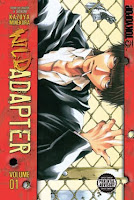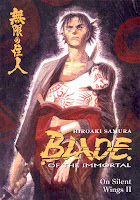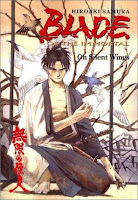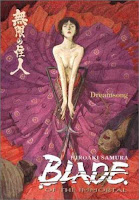My News and Reviews
I don’t have much to say news-wise about this past week, but I did post a couple of reviews. Oishinbo, A la Carte: Sake happens to be my first in-depth manga review for June. I love food and I love manga, so Oishinbo is a great match for me. The second review I wrote in part for the Japanese Literature Book Group—Kōbō Abe’s novel The Woman in the Dunes is a rather strange, but still compelling, story.
This week starts the Wild Adapter Manga Moveable Feast! I’ve been looking forward to this Feast since I love Kazuya Minekura’s Wild Adapter. Below, I have a few quick comments on the series as a whole. Later this week I’ll be talking a little bit about mahjong (it’s related, I promise) and will be reviewing the first volume in the series.
And one last thing! The dates and location for the next MangaNEXT manga convention have been announced: February 24-26, 2012 at the Sheraton Meadowlands in East Rutherford, New Jersey. MangaNEXT is the only manga specific convention that I know of, so I’m going to make a concerted effort to get there in February. Believe it or not, I’ve never actually been to any sort of convention before.
Quick Takes
 Jazz, Volumes 1-4 written by Tamotsu Takamure and illustrated by Sakae Maeda. The relationship between Naoki and Narusawa is extraordinarily unhealthy and abusive. While this certainly makes for intense drama, it is not at all romantic. I wouldn’t even call it a love story, even though the manga presents itself as such. The first two volumes handle the situation in an interesting way, focusing on the turmoil of the characters’ emotions. Unfortunately, the last two volumes don’t seem to work as well once they’ve fallen in “love” with each other. Things don’t work perfectly for them, and they certainly still have their ups and downs, but I have a hard time believing in their relationship.
Jazz, Volumes 1-4 written by Tamotsu Takamure and illustrated by Sakae Maeda. The relationship between Naoki and Narusawa is extraordinarily unhealthy and abusive. While this certainly makes for intense drama, it is not at all romantic. I wouldn’t even call it a love story, even though the manga presents itself as such. The first two volumes handle the situation in an interesting way, focusing on the turmoil of the characters’ emotions. Unfortunately, the last two volumes don’t seem to work as well once they’ve fallen in “love” with each other. Things don’t work perfectly for them, and they certainly still have their ups and downs, but I have a hard time believing in their relationship.
 Ohikkoshi by Hiroaki Samura. Blade of the Immortal is one of my favorite manga series and so I was interested in reading other manga by Hiroaki Samura. Ohikkoshi is the only other of his works currently available in English and I’m very glad that Dark Horse published it. It’s a delightfully quirky, absurd, and odd manga. The titular “Ohikkoshi,” a peculiar romantic comedy with over-the-top tendencies, is followed by two unrelated short stories: the bizarrely ludicrous “Luncheon of Tears Diary” and the autobiographical “Kyoto Super Barhopping Journal.” Samura has no problem with breaking the fourth wall, often to hilarious effect. While this collection doesn’t really present opportunities for epic battles, Samura’s artwork remains wonderfully kinetic.
Ohikkoshi by Hiroaki Samura. Blade of the Immortal is one of my favorite manga series and so I was interested in reading other manga by Hiroaki Samura. Ohikkoshi is the only other of his works currently available in English and I’m very glad that Dark Horse published it. It’s a delightfully quirky, absurd, and odd manga. The titular “Ohikkoshi,” a peculiar romantic comedy with over-the-top tendencies, is followed by two unrelated short stories: the bizarrely ludicrous “Luncheon of Tears Diary” and the autobiographical “Kyoto Super Barhopping Journal.” Samura has no problem with breaking the fourth wall, often to hilarious effect. While this collection doesn’t really present opportunities for epic battles, Samura’s artwork remains wonderfully kinetic.
 The Other Side of the Mirror, Volumes 1-2 by Jo Chen. While marketed as and often called manga, technically The Other Side of the Mirror is a manhua from Taiwan. I am a huge fan of Jo Chen’s artwork and so when I learned that she wrote a comic, I decided to pick it up. Unfortunately, it wasn’t as good as I was hoping it would be. While the artwork is quite nice, the narrative is a mess. The story has potential and there are some lovely moments, but overall it’s fairly muddled. I much preferred the short stories included in the two volumes. Maybe Chen just wasn’t ready yet for a longer, more involved work (“The Other Side of the Mirror” was one of her first comics.) I do like the illustrations, though.
The Other Side of the Mirror, Volumes 1-2 by Jo Chen. While marketed as and often called manga, technically The Other Side of the Mirror is a manhua from Taiwan. I am a huge fan of Jo Chen’s artwork and so when I learned that she wrote a comic, I decided to pick it up. Unfortunately, it wasn’t as good as I was hoping it would be. While the artwork is quite nice, the narrative is a mess. The story has potential and there are some lovely moments, but overall it’s fairly muddled. I much preferred the short stories included in the two volumes. Maybe Chen just wasn’t ready yet for a longer, more involved work (“The Other Side of the Mirror” was one of her first comics.) I do like the illustrations, though.
 Wild Adapter, Volumes 1-6 by Kazuya Minekura. Although Kubota and Tokito are the series main characters, each volume of this manga features a secondary character around whom the story is framed. It’s an interesting narrative technique and it actually works quite well. The character and personalities of the young men are slowly revealed through the others’ perspectives. And while the exact nature of their relationship is never explicitly stated or revealed and is the subject of much speculation, it is obvious that it is a very close and intimate one. Wild Adapter is unfinished at six volumes (and a few chapters), the series having been put on hiatus due to Minekura’s health. I really do hope to see more in English, but now that Tokyopop is no more it is unfortunately unlikely.
Wild Adapter, Volumes 1-6 by Kazuya Minekura. Although Kubota and Tokito are the series main characters, each volume of this manga features a secondary character around whom the story is framed. It’s an interesting narrative technique and it actually works quite well. The character and personalities of the young men are slowly revealed through the others’ perspectives. And while the exact nature of their relationship is never explicitly stated or revealed and is the subject of much speculation, it is obvious that it is a very close and intimate one. Wild Adapter is unfinished at six volumes (and a few chapters), the series having been put on hiatus due to Minekura’s health. I really do hope to see more in English, but now that Tokyopop is no more it is unfortunately unlikely.
 Bullet Ballet directed by Shinya Tsukamoto. Goda, a successful commercial director, is completely taken aback by the suicide of his girlfriend of ten years. He can’t comprehend why she killed herself and has no idea where she even got the gun. He becomes obsessed with obtaining a gun of the same make and model—a desire that consumes him. But after reaching his goal his life becomes more complicated. In the process, he becomes entangled with a local gang and things can’t possibly end well for any of them. Filmed in black and white, Bullet Ballet is a visually interesting film even if it can be difficult to follow at times. I also happened to really like Chu Ishikawa’s industrial styled soundtrack
Bullet Ballet directed by Shinya Tsukamoto. Goda, a successful commercial director, is completely taken aback by the suicide of his girlfriend of ten years. He can’t comprehend why she killed herself and has no idea where she even got the gun. He becomes obsessed with obtaining a gun of the same make and model—a desire that consumes him. But after reaching his goal his life becomes more complicated. In the process, he becomes entangled with a local gang and things can’t possibly end well for any of them. Filmed in black and white, Bullet Ballet is a visually interesting film even if it can be difficult to follow at times. I also happened to really like Chu Ishikawa’s industrial styled soundtrack
 Tiger & Bunny, Episodes 8-12 directed by Keiichi Satou. The animation quality seems to be a little inconsistent in these later episodes, and the plot as well, but it is still a very fun series. I am very much enjoying Tiger & Bunny and I like the characters immensely. While the main plot is developing nicely, I particularly enjoy the side stories that feature a particular hero. In these episodes, we get a chance to learn a bit more about Origami Cyclone and Dragon Kid. I do wish Lunatic wasn’t pushed into the background so soon, though. There will be at least fifteen episodes to the series, but I hope to see more than that. I have a hard time believing everything will be able to be wrapped up satisfactorily in such a short period of time.
Tiger & Bunny, Episodes 8-12 directed by Keiichi Satou. The animation quality seems to be a little inconsistent in these later episodes, and the plot as well, but it is still a very fun series. I am very much enjoying Tiger & Bunny and I like the characters immensely. While the main plot is developing nicely, I particularly enjoy the side stories that feature a particular hero. In these episodes, we get a chance to learn a bit more about Origami Cyclone and Dragon Kid. I do wish Lunatic wasn’t pushed into the background so soon, though. There will be at least fifteen episodes to the series, but I hope to see more than that. I have a hard time believing everything will be able to be wrapped up satisfactorily in such a short period of time.




